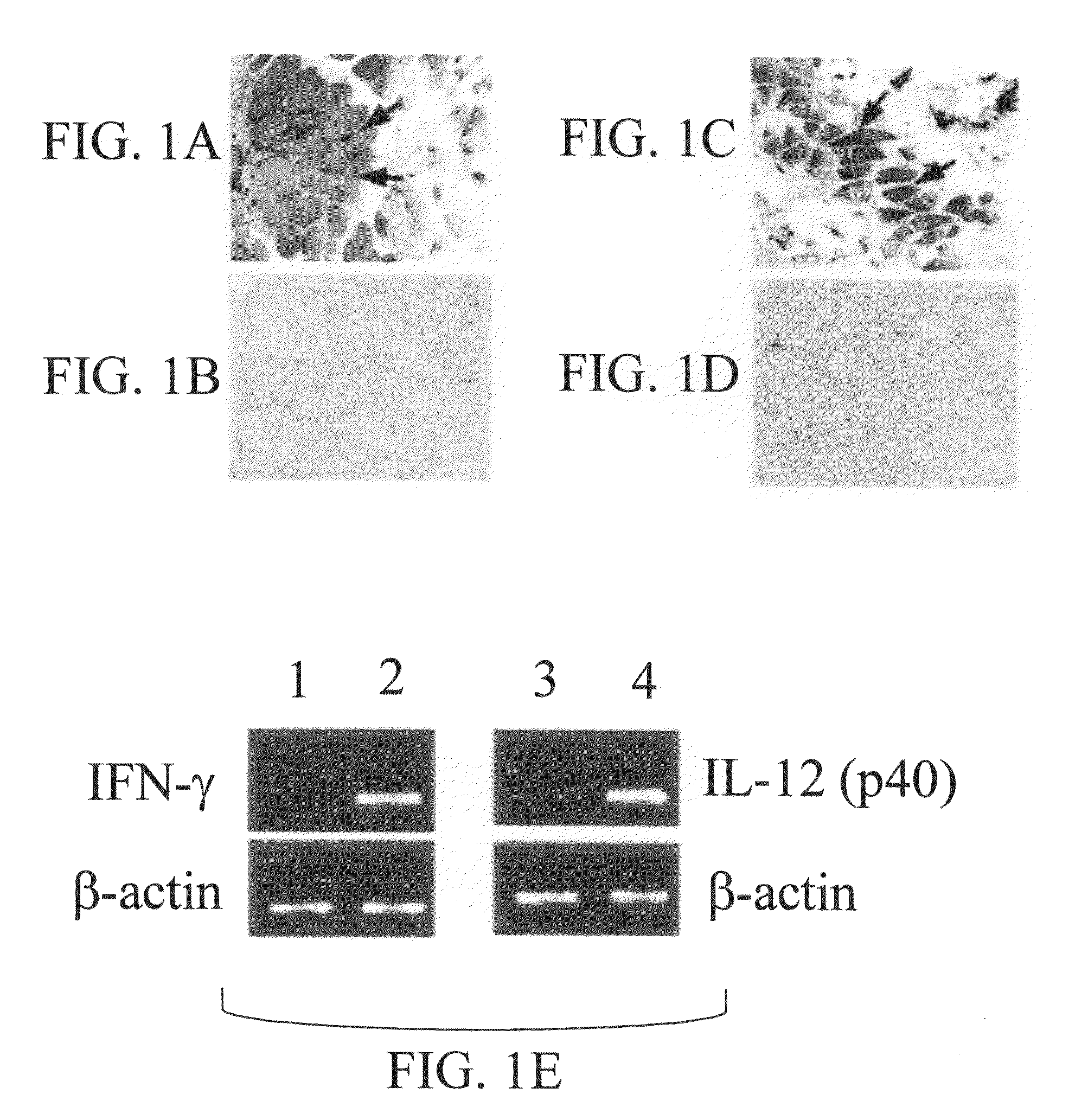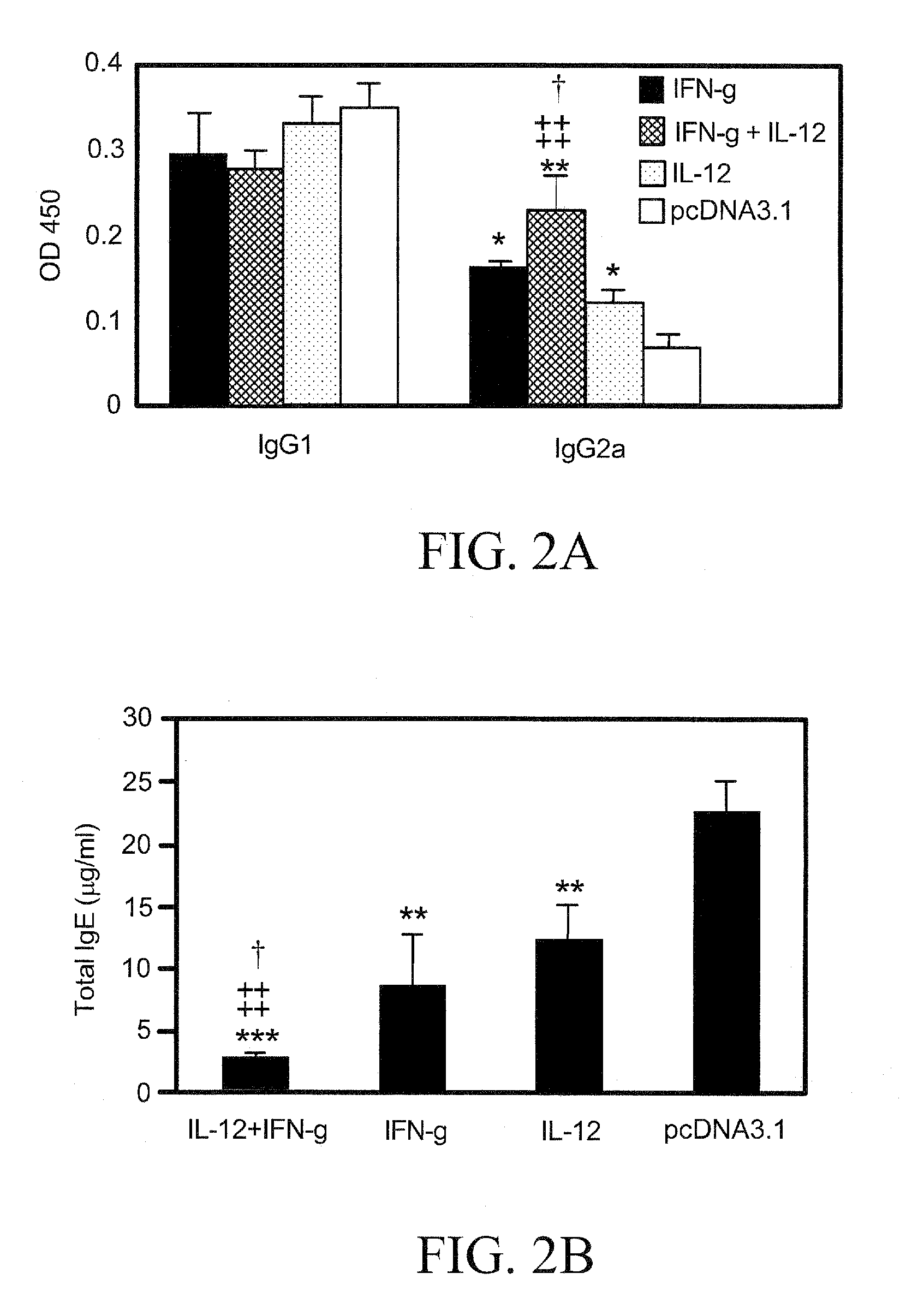Genetic adjuvants for immunotherapy
a technology of immunotherapy and gene adjuvants, applied in the field of gene adjuvants for immunotherapy, can solve the problems of frequent dosing, inconvenient and uncomfortable frequent dosing, and severe systemic reactions, and achieve the effect of not suppressing established allergic responses by odns
- Summary
- Abstract
- Description
- Claims
- Application Information
AI Technical Summary
Problems solved by technology
Method used
Image
Examples
example 1
Plasmid Constructs and Expression of IL-12 and IFN-γ
[0068]The 2 subunits of murine IL-12, p35 and p40, were cloned into the same pcDNA3.1 vector. The cloning strategy was such that each subunit was under the transcriptional control of an individual CMV immediate-early promoter and also had its own BGH poly A sequences derived from the vector pcDNA3.1. Mice given pIFN-γ or pIL-12 exhibited expression of the IFN-γ or IL-12 p40 subunit, respectively, in their muscle, as observed by immunohistochemical staining of the muscle tissues (FIGS. 1A and 1C). No immunostaining was observed in a control group of mice that received the empty vector pcDNA3.1 (FIGS. 1B and 1D). The results of RT-PCR analyses of muscle mRNAs revealed that mice given either pIFN-γ or pIL-12 (FIG. 1E, lane 2 and lane 4), but not the control group of mice (FIG. 1E, lane 1 and lane 3), expressed IFN-γ and IL-12 p40 subunit-specific mRNAs, respectively.
example 2
Cytokine Genetic Adjuvants Inhibit Production of IgE Antibodies and Enhanced Production of IgG2a Antibodies
[0069]Four groups of mice (n=6) were vaccinated 3 times, as described in connection with the vaccination protocol. Sera were collected on day 21 after KBG immunization for an antibody assay. As shown in FIGS. 2A and 2B, mice given cytokine plasmid(s) as an adjuvant exhibited significantly lower total IgE levels than control mice (P<0.01). The group of mice given both pIL-12 and pIFN-γ constructs revealed a significantly lower amount of total IgE than mice given pIL-12 (P<0.01) or pIFN-γ (P<0.05) alone (FIG. 2B). There was also an increase in antigen-specific IgG2a levels (P<0.01) in mice given pIFN-γ plus pIL-12 as an adjuvant in comparison with the control mice and the mice receiving either plasmid alone (FIG. 2A). However, no significant difference was observed for antigen-specific IgG 1 antibody levels among the cytokine pDNA-vaccinated and control groups of mice (FIG. 2A). ...
example 3
Cytokine Genetic Adjuvants Alter the Cytokine Profiles of Splenocytes
[0070]Four groups of mice (n=6) were vaccinated 3 times as described in connection with the vaccination protocol. Spleens were removed on day 7, after KBG immunization, and cultured in vitro for assessment of TH1-like cytokines IL-2 and IFN-γ or TH2-like cytokine IL-4. Mice given cytokine pDNA adjuvants produced more TH1-like cytokines than did the controls (FIGS. 3A-3C). Mice given combined pIFN-γ and pIL-12 produced higher amounts of IFN-γ (194.64 pg / mL) than mice given pIFN-γ (100.14 pg / mL) or pIL-12 (111.87 pg / mL) alone. Control mice produced only 11.71 pg / mL IFN-γ (FIG. 3A). Mice vaccinated with pDNA cytokine(s) adjuvant produced more IL-2 than did control mice. IL-2 levels after vaccinations were as follows: pIFN-γ, 73.68 pg / mL; pIL-12, 128.43 pg / mL; pIFN-γ plus pIL-12, 202.57 pg / mL; and pcDNA3.1 (control), 51.88 pg / mL (FIG. 3A). In contrast, control mice, which were vaccinated only with the empty vector plas...
PUM
| Property | Measurement | Unit |
|---|---|---|
| molecular weight | aaaaa | aaaaa |
| molecular weight | aaaaa | aaaaa |
| molecular weight | aaaaa | aaaaa |
Abstract
Description
Claims
Application Information
 Login to View More
Login to View More - R&D
- Intellectual Property
- Life Sciences
- Materials
- Tech Scout
- Unparalleled Data Quality
- Higher Quality Content
- 60% Fewer Hallucinations
Browse by: Latest US Patents, China's latest patents, Technical Efficacy Thesaurus, Application Domain, Technology Topic, Popular Technical Reports.
© 2025 PatSnap. All rights reserved.Legal|Privacy policy|Modern Slavery Act Transparency Statement|Sitemap|About US| Contact US: help@patsnap.com



